Real-Time Damage Detection in an Airplane Wing During Wind Tunnel Testing Under Realistic Flight Conditions
Abstract
1. Introduction
2. The Composite Airplane Wing with Adjustable Damage
3. The Fiber Sensing Array and Data Acquisition System
4. The Wind Tunnel Setup
5. Data Processing Methodology, Both Preparatory and Real-Time
5.1. Principal Component Analysis
5.2. Hotelling Measure
5.3. The Q Measure
6. Test Procedure
7. Results and Their Analysis
7.1. Comparing Segments of Equal Airspeed
7.2. Comparing Complete Traces
8. Summary and Conclusions
Author Contributions
Funding
Data Availability Statement
Conflicts of Interest
Appendix A
Appendix A.1. On the Use of Fiber Sensing Networks in SHM Applications
- The proper operation of the FBG fiber sensing net requires the correct placement of each FBG to ensure linear strain transfer between the FBG and the underlying measured structure.
- Optical fiber integration in aircraft structures is not limited by length or size. Sensor integration, including embedding, surface bonding using a dedicated sensing mat, egress/ingress concepts and repairability were demonstrated in the EU SARISTU project [40] on a real aircraft structure demonstrator. Yet practical issues, such as price, maintenance and the inability of the FBG to sense remote events that do not affect the strain surrounding the FBG, may limit the use of FBG-based sensing techniques to monitor only discrete troublesome hot spots.
- Optical fibers, including FBGs inscribed within them, are well known for their ability to withstand harsh environmental conditions [41,42]. This robustness makes them ideal for applications in communications, aerospace, civil engineering, oil and gas and structural health monitoring. However, besides being sensitive to strain, the peak reflection wavelength () of the FBG is also influenced by temperature (through its effect on fiber core, cladding and coating [38]) and humidity (coating only [39,43]). A robust and commonly preferred method to eliminate the temperature sensitivity of the strain-measuring FBG array is to attach or embed an auxiliary strain-isolated, temperature-only sensing FBG array quite close to the primary array. Once the temperature sensitivity of the primary array is accurately characterized, the data from the other array can be used to extract temperature-independent strain information from the primary FBG array. As for humidity, compensation can be implemented provided that the actual value of humidity in the vicinity of the FBG is measured independently and the dependence of on this parameter has been calibrated.
- FBG sensing for SHM is commonly used for strain monitoring. Thus, buckling, delamination, debonding and cracks, all types of damage associated with a loss of stiffness, can be handled by the proposed system after thorough testing and verification, preferably combined with a digital twin.
- Long-term operation of such a damage-detecting SHM system depends on quite a few factors. Modern FBG interrogators have reasonable long-term stability and can be easily calibrated, if necessary. While the FBGs themselves are known to be quite stable, their actual behavior also critically depends on the stability of the matrix they are embedded in or attached to. Under these circumstances, timely calibration will be required. The dynamic effects of temperature and humidity will have to be compensated for, as described above. In any case, it is too early to obtain a reliable estimate of the expected measurement error of such a system over an extended period.
Appendix A.2. On the Use of PCA-Based Algorithms
- Despite the high degree of similarity among a family of same-model structures, a PCA model constructed for one family member may be used for another member only after thorough verification and validation.
- Under realistic flight conditions, involving mixed-mode loading and a noisy environment, a single statistic may not be sufficient to definitively assess the health status of the structure.
- The operation of the PCA-based algorithm must be tested under dynamic nonlinear maneuvers of the structure.
References
- Farrar, C.R.; Lieven, N.A. Damage prognosis: The future of structural health monitoring. Philos. Trans. R. Soc. A Math. Phys. Eng. Sci. 2007, 365, 623–632. [Google Scholar] [CrossRef] [PubMed]
- Boller, C. Structural health monitoring—An introduction and definitions. In Encyclopedia of Structural Health Monitoring; John Wiley & Sons: Hoboken, NJ, USA, 2009. [Google Scholar]
- Farrar, C.R.; Worden, K. Structural Health Monitoring: A Machine Learning Perspective; Wiley: New York, NY, USA, 2012. [Google Scholar]
- Wild, G.; Pollock, L.; Abdelwahab, A.K.; Murray, J. The Need for Aerospace Structural Health Monitoring: A review of aircraft fatigue accidents. Int. J. Progn. Health Manag. 2021, 12, 1–16. [Google Scholar] [CrossRef]
- Code of Federal Regulations. Available online: https://www.govinfo.gov/content/pkg/CFR-2017-title14-vol1/xml/CFR-2017-title14-vol1-sec23-573.xml (accessed on 10 July 2025).
- NATO Standardization Agency. STANAG 4671(Edition 1)—UAV Systems Airworthiness Requirements (USAR) for North Atlantic Treaty Organization (NATO) Military UAV Systems. 2009. Available online: http://everyspec.com/NATO/NATO-STANAG/STANAG_4617_DRAFT_22MAR2007_51639/ (accessed on 10 July 2025).
- Foote, P. New guidelines for implementation of structural health monitoring in aerospace applications. SAE Int. J. Aerosp. 2013, 6, 525–533. [Google Scholar] [CrossRef]
- Piotrowski, D. Overview of SHM in airline maintenance: Challenges and opportunities. In Structural Health Monitoring/Management (SHM) in Aerospace Structures; Elsevier: Amsterdam, The Netherlands, 2024; pp. 3–14. [Google Scholar]
- Singh, C.D.; Singh, D.; Singh, K.J.; Kaur, H. (Eds.) Condition-Based Maintenance and Residual Life Prediction; John Wiley & Sons: Hoboken, NJ, USA, 2025. [Google Scholar]
- Tseremoglou, I.; Santos, B.F. Condition-based maintenance scheduling of an aircraft fleet under partial observability: A deep reinforcement learning approach. Reliab. Eng. Syst. Saf. 2023, 241, 109582. [Google Scholar] [CrossRef]
- Yuan, F.-G. (Ed.) Structural Health Monitoring/Management (SHM) in Aerospace Structures; Elsevier: Amsterdam, The Netherlands, 2024. [Google Scholar]
- Baptista, M.L.; Delgado, F.; Eskue, N.; Chao, M.A.; Goebel, K. Integrating Prognostics and Health Management in the Design and Manufacturing of Future Aircraft. In Artificial Intelligence for Smart Manufacturing and Industry X. 0; Springer Nature: Cham, Switzerland, 2025; pp. 121–145. [Google Scholar]
- Oliveira, T.L.L.; Hadded, M.; Mimouni, S.; Schaan, R.B. The Role of Non-Destructive Testing of Composite Materials for Aerospace Applications. NDT 2025, 3, 3. [Google Scholar] [CrossRef]
- Boopathy, G.; Surendar, G.; Nema, A.; Anand, T.P. Review on non-destructive testing of composite materials in aircraft applications. Int. J. Mech. Eng. Technol. 2017, 8, 1334–1342. [Google Scholar]
- Apuleo, G.; Ciminello, M.; Pellone, L.; Mercurio, U.; Concilio, A. Application of a Fiber Optic-Based SHM System to a Composite Aircraft Wing and Its Technological Maturity Evaluation. Eng. Proc. 2025, 90, 31. [Google Scholar]
- Blond, K.; O’brien, T.; Thompson, N.; Piotrowski, D.; Clark, A. Comparative Vacuum Monitoring Solutions to Advance US Air Force KC-46A Condition-Based Maintenance Plus. Aerospace 2023, 10, 587. [Google Scholar] [CrossRef]
- Kressel, I.; Dorfman, B.; Botsev, Y.; Handelman, A.; Balter, J.; Pillai, A.C.R.; Prasad, M.H.; Gupta, N.; Joseph, A.M.; Sundaram, R.; et al. Flight validation of an embedded structural health monitoring system for an unmanned aerial vehicle. Smart Mater. Struct. 2015, 24, 075022. [Google Scholar] [CrossRef]
- Tibaduiza Burgos, D.A.; Gomez Vargas, R.C.; Pedraza, C.; Agis, D.; Pozo, F. Damage identification in structural health monitoring: A brief review from its implementation to the use of data-driven applications. Sensors 2020, 20, 733. [Google Scholar] [CrossRef] [PubMed]
- Preisighe Viana, M.V. In-Flight Evaluation of Multipoint Loads Model for Flexible Aircraft Loads Monitoring. In Proceedings of the AIAA SCITECH 2025 Forum, Orlando, FL, USA, 6–10 January 2025. [Google Scholar] [CrossRef]
- Konforty, S.; Khmelnitsky, M.; Kressel, I.; Klein, R.; Tur, M.; Bortman, J. Bearing health monitoring using optical fiber sensors. Phm Soc. Eur. Conf. 2016, 3, 1–7. [Google Scholar] [CrossRef]
- Tur, M.; Sovran, I.; Bergman, A.; Motil, A.; Shapira, O.; Ben-Simon, U.; Kressel, I.; Kalinowski, H.J.; Fabris, J.L.; Bock, W.J. Structural health monitoring of composite-based UAVs using simultaneous fiber optic interrogation by static Rayleigh-based distributed sensing and dynamic fiber Bragg grating point sensors. In Proceedings of the 24th International Conference on Optical Fibre Sensors, Curitiba, Brazil, 28 September–2 October 2015; Volume 9634. [Google Scholar]
- Guemes, A.; Pintado, J.M.; Frovel, M.; R-Lence, F.; Menedez, J.M. Embedded fibre bragg gratings for damage detection in composites. In Proceedings of the SHM2003—Proceedings of 4th International Workshop on Structural Health Monitoring, Stanford, CA USA, 15–17 September 2003; Chang, F.-K., Ed.; DEStech Publications: Lancaster, PA, USA, 2003. [Google Scholar]
- Hokama Razzini, A. Development of an Optimal Sensor Placement Framework for Structural Health Monitoring of an Aircraft Wing’s Spar. Doctoral Dissertation, UC San Diego, La Jolla, CA, USA, 2024. [Google Scholar]
- Zakirov, R.; Giyasova, F. Application of fiber-optic sensors for the aircraft structure monitoring. In Safety in Aviation and Space Technologies: Select Proceedings of the 9th World Congress “Aviation in the XXI Century”; Springer International Publishing: Cham, Switzerland, 2021. [Google Scholar]
- Güemes, A.; Fernandez-Lopez, A. Structural health monitoring with fiber optic sensors. In Proceedings of the 23rd International Conference on Optical Fibre Sensors, Santander, Spain, 2–6 June 2014; Volume 9157. [Google Scholar]
- Sierra-Pérez, J.; Alvarez-Montoya, J. Damage detection in composite aerostructures from strain and telemetry data fusion by means of pattern recognition techniques. In Proceedings of the 9th European Workshop on Structural Health Monitoring, Manchester, UK, 10–13 July 2018. [Google Scholar]
- Udd, E.; Spillman, W.B., Jr. (Eds.) Fiber Optic Sensors: An Introduction for Engineers and Scientists; John Wiley & Sons: Hoboken, NJ, USA, 2024. [Google Scholar]
- Rocha, H.; Semprimoschnig, G.; Nunes, J.P. Sensors for process and structural health monitoring of aerospace composites: A review. Eng. Struct. 2021, 237, 112231. [Google Scholar] [CrossRef]
- Qiu, H.; Rosafalco, L.; Ghisi, A.; Mariani, S. Structural Health-Monitoring Strategy Based on Adaptive Kalman Filtering. Eng. Proc. 2024, 82, 76. [Google Scholar]
- Chin, C.; Abdullah, S.; Ariffin, A.; Singh, S.; Arifin, A. A review of the wavelet transform for durability and structural health monitoring in automotive applications. Alex. Eng. J. 2024, 99, 204–216. [Google Scholar] [CrossRef]
- Dey, S.; Saikat, K.S.; Kalyan, K.M. Frequency Domain Vibration Analysis. In Intelligent Manufacturing and Energy Sustainability: Proceedings of ICIMES; Springer Singapore: Singapore, 2021; Volume 265, p. 509. [Google Scholar]
- Satpal, S.B.; Khandare, Y.; Guha, A.; Banerjee, S. Structural health monitoring of a cantilever beam using support vector machine. Int. J. Adv. Struct. Eng. 2013, 5, 2. [Google Scholar] [CrossRef]
- Jackson, J.E. A User’s Guide to Principal Components; John Wiley & Sons: Hoboken, NJ, USA, 2005. [Google Scholar]
- Mujica, L.E.; Ruiz, M.; Pozo, F.; Rodellar, J.; Güemes, A. A structural damage detection indicator based on principal component analysis and statistical hypothesis testing. Smart Mater. Struct. 2013, 23, 025014. [Google Scholar] [CrossRef]
- Mujica, L.; Rodellar, J.; Fernández, A.; Güemes, A. Q-statistic and T2-statistic PCA-based measures for damage assessment in structures. Struct. Health Monit. 2010, 10, 539–553. [Google Scholar] [CrossRef]
- Sierra-Pérez, J.; Güemes, A.; Mujica, L.E.; Ruiz, M. Damage detection in composite materials structures under variable loads conditions by using fiber Bragg gratings and principal component analysis, involving new unfolding and scaling methods. J. Intell. Mater. Syst. Struct. 2015, 26, 1346–1359. [Google Scholar] [CrossRef]
- Tong, C.D.; Yan, X.F.; Ma, Y.X. Statistical process monitoring based on improved principal component analysis and its application to chemical processes. J. Zhejiang Univ. A 2013, 14, 520–534. [Google Scholar] [CrossRef][Green Version]
- Othonos, A.; Kalli, K. Fiber Bragg Gratings: Fundamentals and Applications in Telecommunications and Sensing; Artech House: London, UK, 1999. [Google Scholar]
- Frövel, M.; Gutiérrez, C.; González, S.; Carrión, G.; Cabrerizo, F.; Pintado, J.M. Influence of temperature and humidity on the performance of FBG-strain sensors embedded in CFRP composites. In Proceedings of the 4th European Workshop on Structural Health Monitoring, Krakow, Poland, 2–4 July 2008. [Google Scholar]
- Wölcken, P.C.; Papadopoulos, M. (Eds.) Smart Intelligent Aircraft Structures (SARISTU): Proceedings of the Final Project Conference; Springer: Berlin/Heidelberg, Germany, 2015. [Google Scholar]
- Di Sante, R.; Donati, L.; Troiani, E.; Proli, P. Reliability and Accuracy of Embedded Fiber Bragg Grating Sensors for Strain Monitoring in Advanced Composite Structure. Met. Mater. Int. 2014, 20, 537–543. [Google Scholar] [CrossRef]
- Frövel, M.; del Olmo, E.; Carrión, G.; Pintado, J.M. Influence of Fatigue Loads and Temperature on the Response of FBGS embedded in Composite Material for Aerospace Applications. In Proceedings of the European Workshop on Structural Health Monitoring, EWSHM 2010, Sorento, Italy, 29 June–2 July 2010. [Google Scholar]
- Aceti, P.; Sala, G. Impact of Moisture Absorption on Optical Fiber Sensors: New Bragg Law Formulation for Monitoring Composite Structures. J. Compos. Sci. 2024, 8, 518. [Google Scholar] [CrossRef]



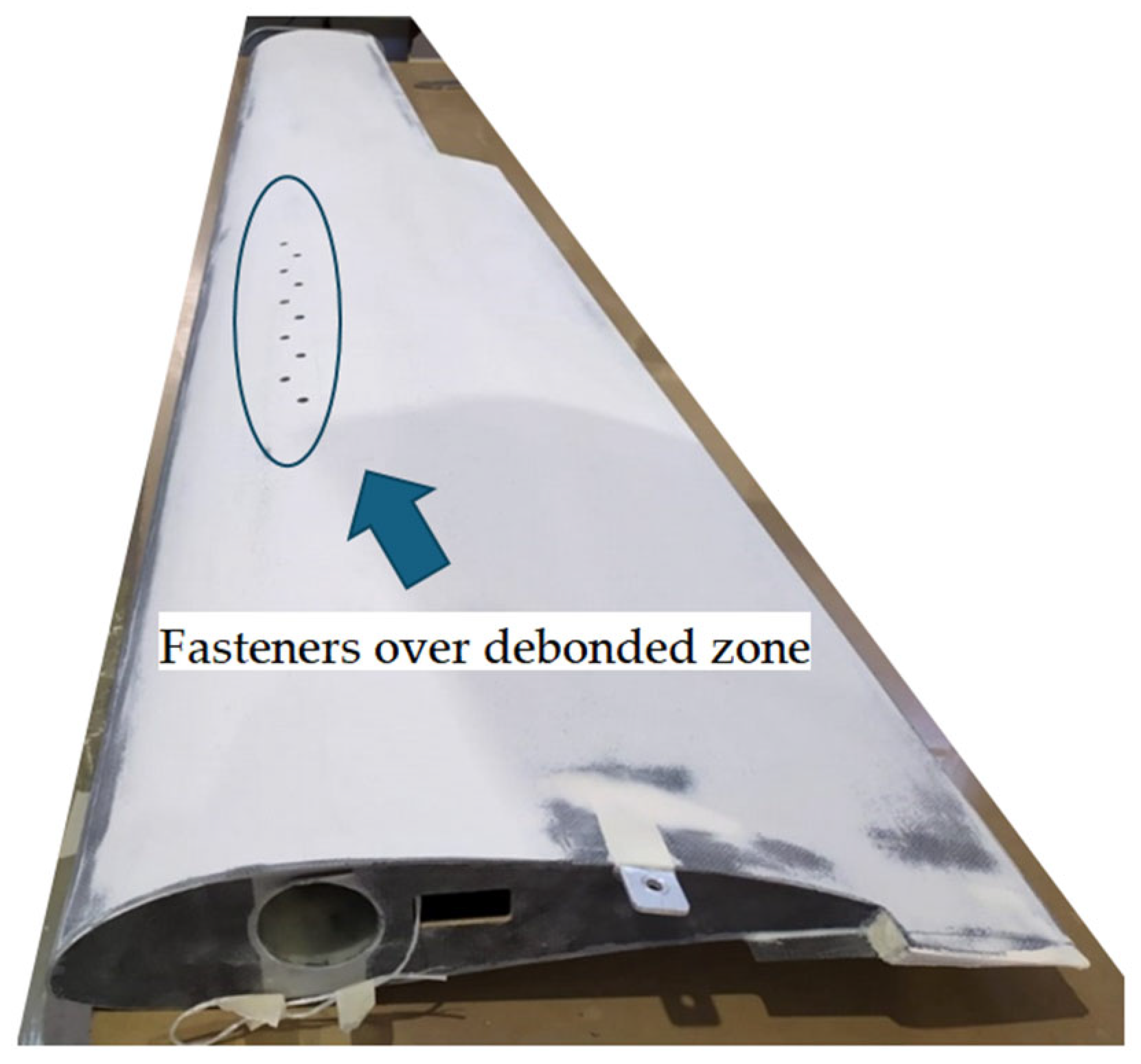


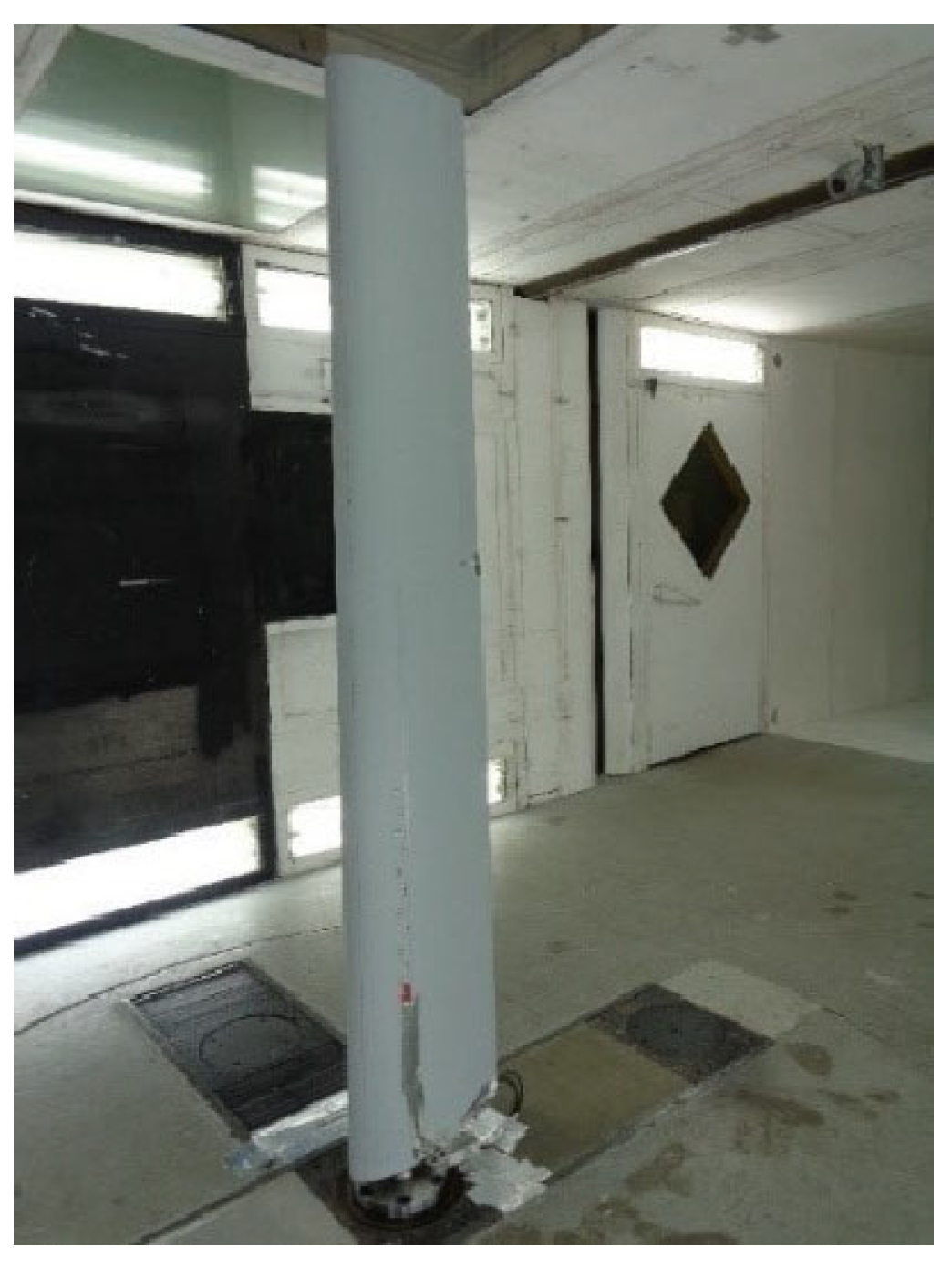
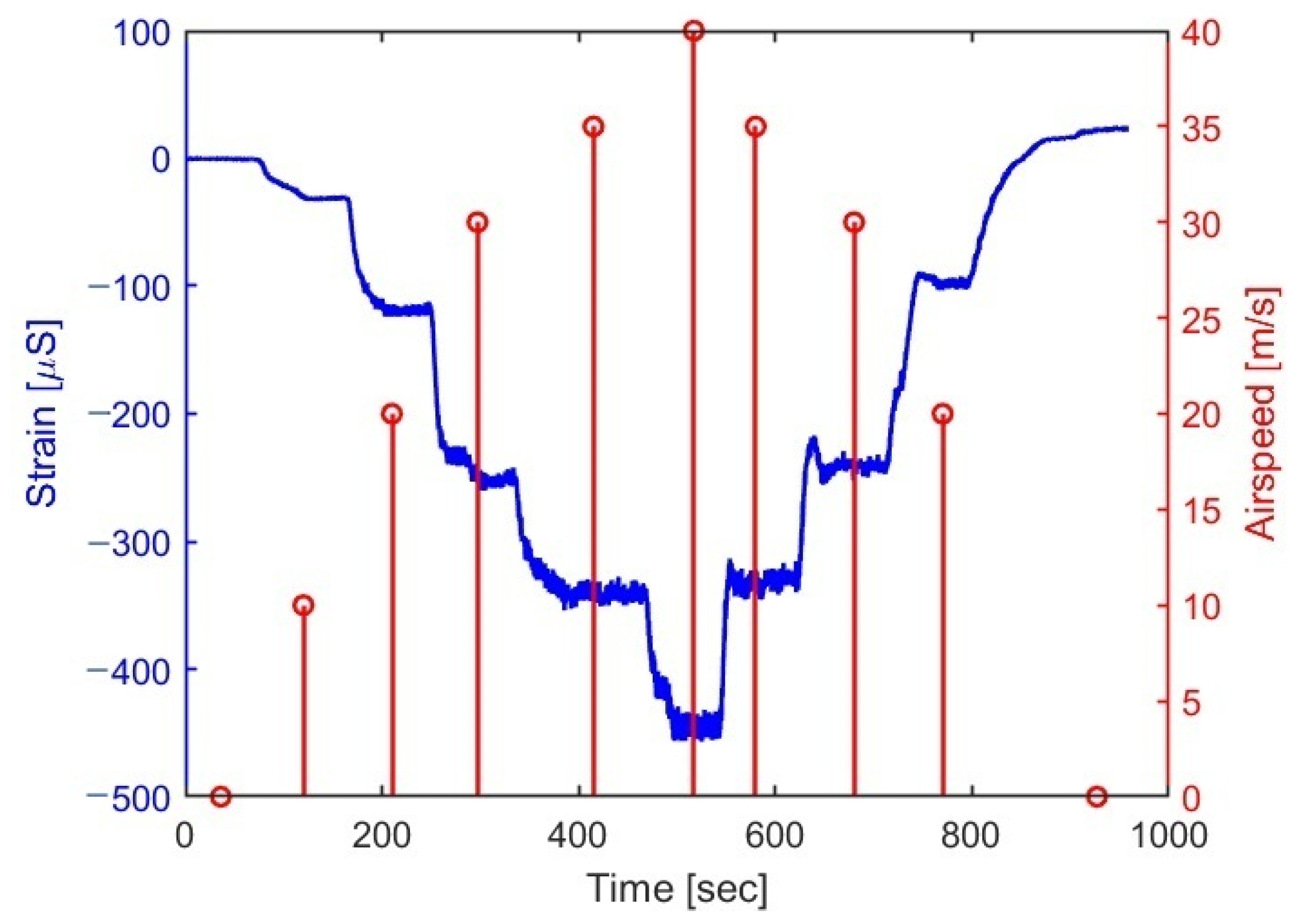
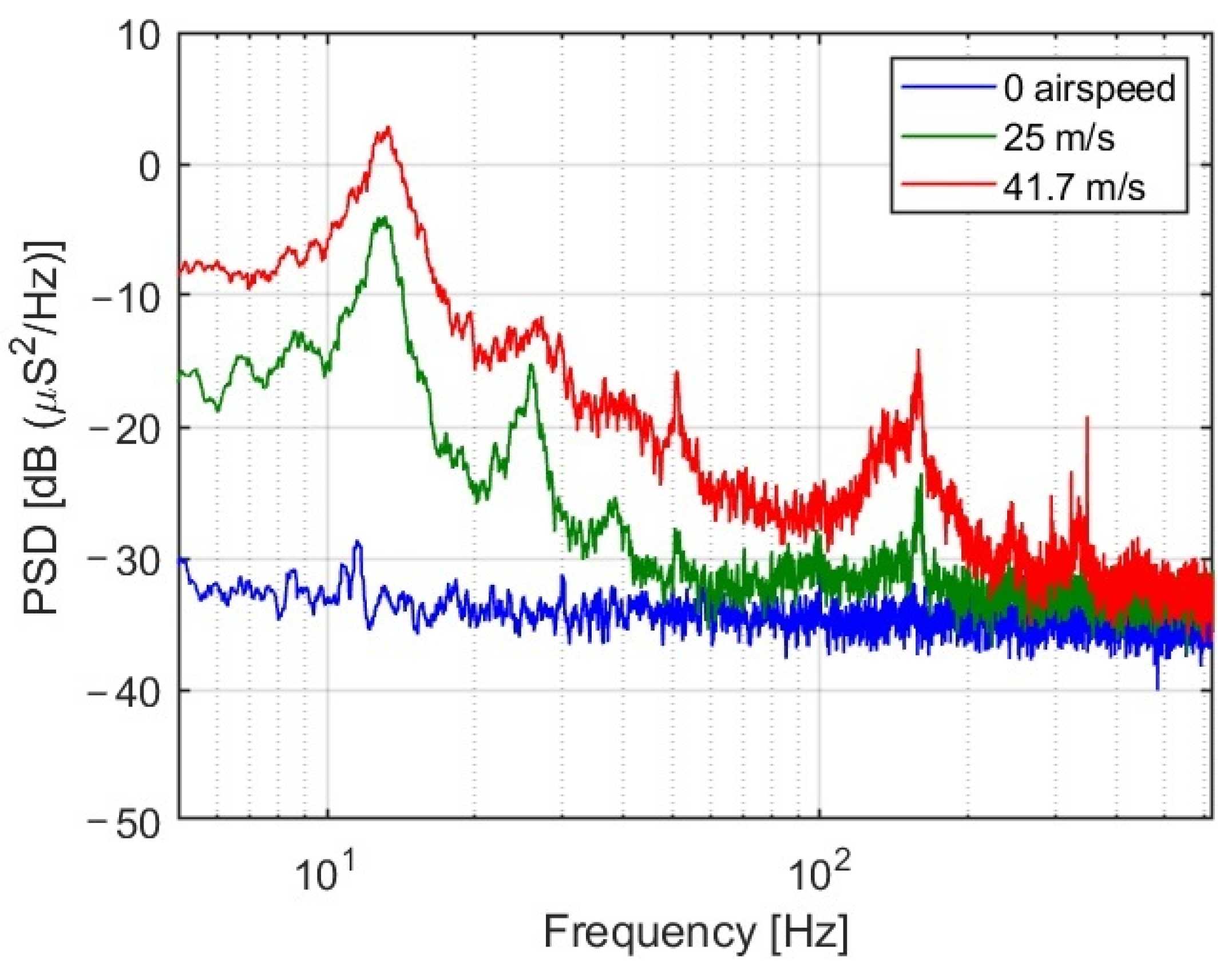
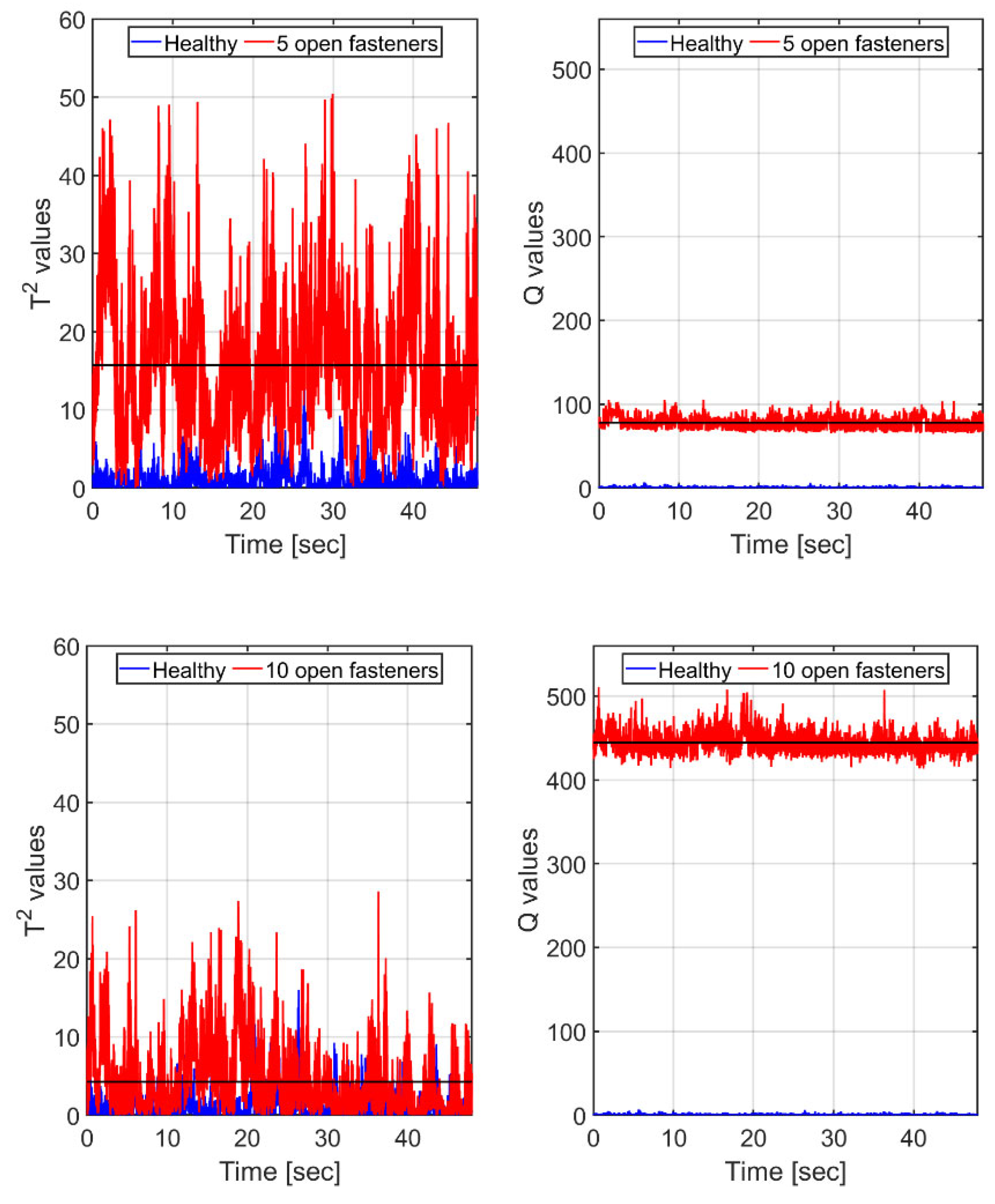
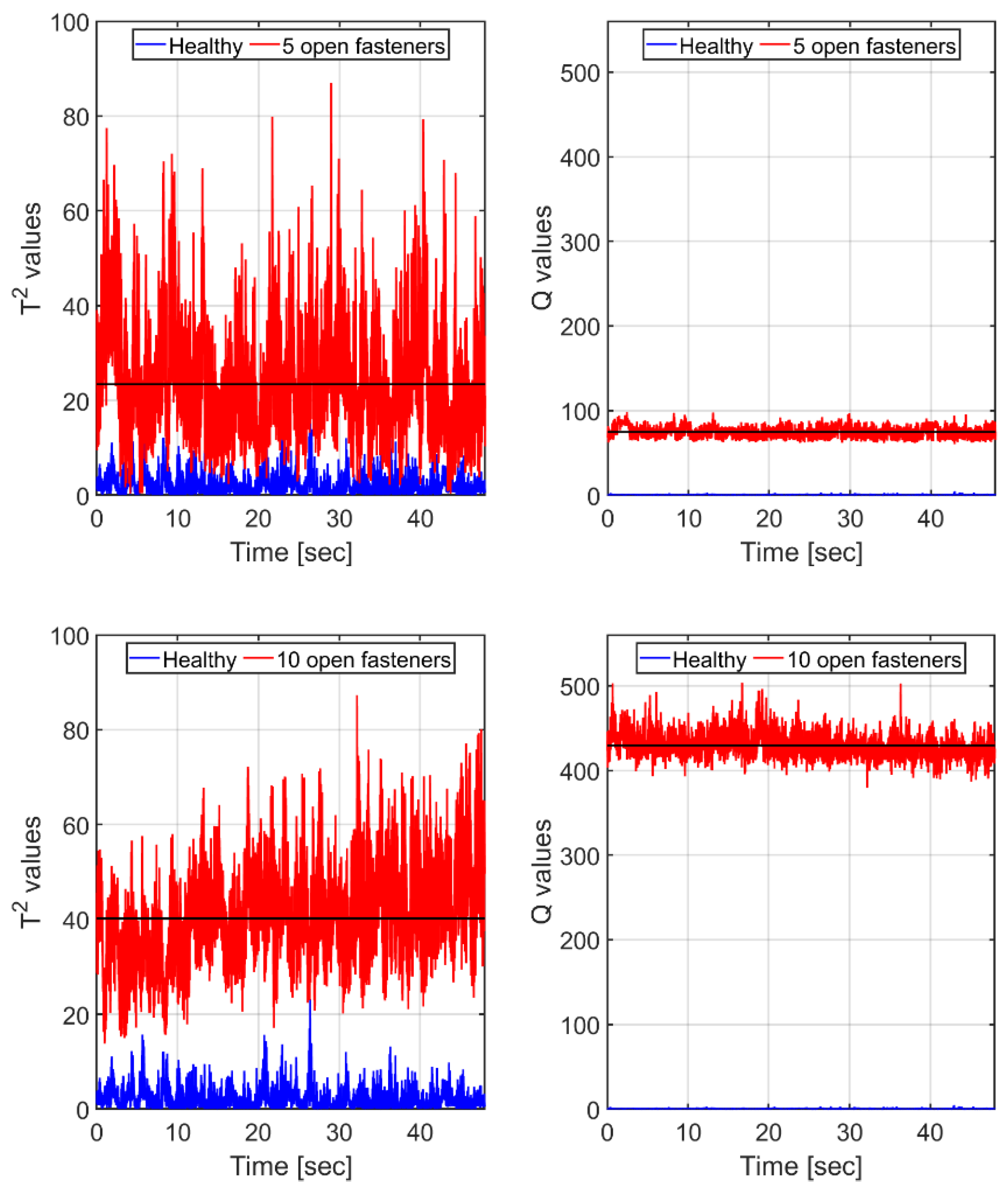

| Experiment | Airspeed [m/s] | Max Lift Force [kgf] | Angle of Attack [°] | Number of Removed Fasteners |
|---|---|---|---|---|
| 1 | 0–41.7 | 108.5 | 4 | 0 |
| 2 | 0–41.8 | 108.5 | 4 | 5 |
| 3 | 0–42 | 107.8 | 4 | 10 |
Disclaimer/Publisher’s Note: The statements, opinions and data contained in all publications are solely those of the individual author(s) and contributor(s) and not of MDPI and/or the editor(s). MDPI and/or the editor(s) disclaim responsibility for any injury to people or property resulting from any ideas, methods, instructions or products referred to in the content. |
© 2025 by the authors. Licensee MDPI, Basel, Switzerland. This article is an open access article distributed under the terms and conditions of the Creative Commons Attribution (CC BY) license (https://creativecommons.org/licenses/by/4.0/).
Share and Cite
Ofir, Y.; Ben-Simon, U.; Shoham, S.; Kressel, I.; Galasso, B.; Mercurio, U.; Concilio, A.; Apuleo, G.; Bohbot, J.; Tur, M. Real-Time Damage Detection in an Airplane Wing During Wind Tunnel Testing Under Realistic Flight Conditions. Sensors 2025, 25, 4423. https://doi.org/10.3390/s25144423
Ofir Y, Ben-Simon U, Shoham S, Kressel I, Galasso B, Mercurio U, Concilio A, Apuleo G, Bohbot J, Tur M. Real-Time Damage Detection in an Airplane Wing During Wind Tunnel Testing Under Realistic Flight Conditions. Sensors. 2025; 25(14):4423. https://doi.org/10.3390/s25144423
Chicago/Turabian StyleOfir, Yoav, Uri Ben-Simon, Shay Shoham, Iddo Kressel, Bernardino Galasso, Umberto Mercurio, Antonio Concilio, Gianvito Apuleo, Jonathan Bohbot, and Moshe Tur. 2025. "Real-Time Damage Detection in an Airplane Wing During Wind Tunnel Testing Under Realistic Flight Conditions" Sensors 25, no. 14: 4423. https://doi.org/10.3390/s25144423
APA StyleOfir, Y., Ben-Simon, U., Shoham, S., Kressel, I., Galasso, B., Mercurio, U., Concilio, A., Apuleo, G., Bohbot, J., & Tur, M. (2025). Real-Time Damage Detection in an Airplane Wing During Wind Tunnel Testing Under Realistic Flight Conditions. Sensors, 25(14), 4423. https://doi.org/10.3390/s25144423







